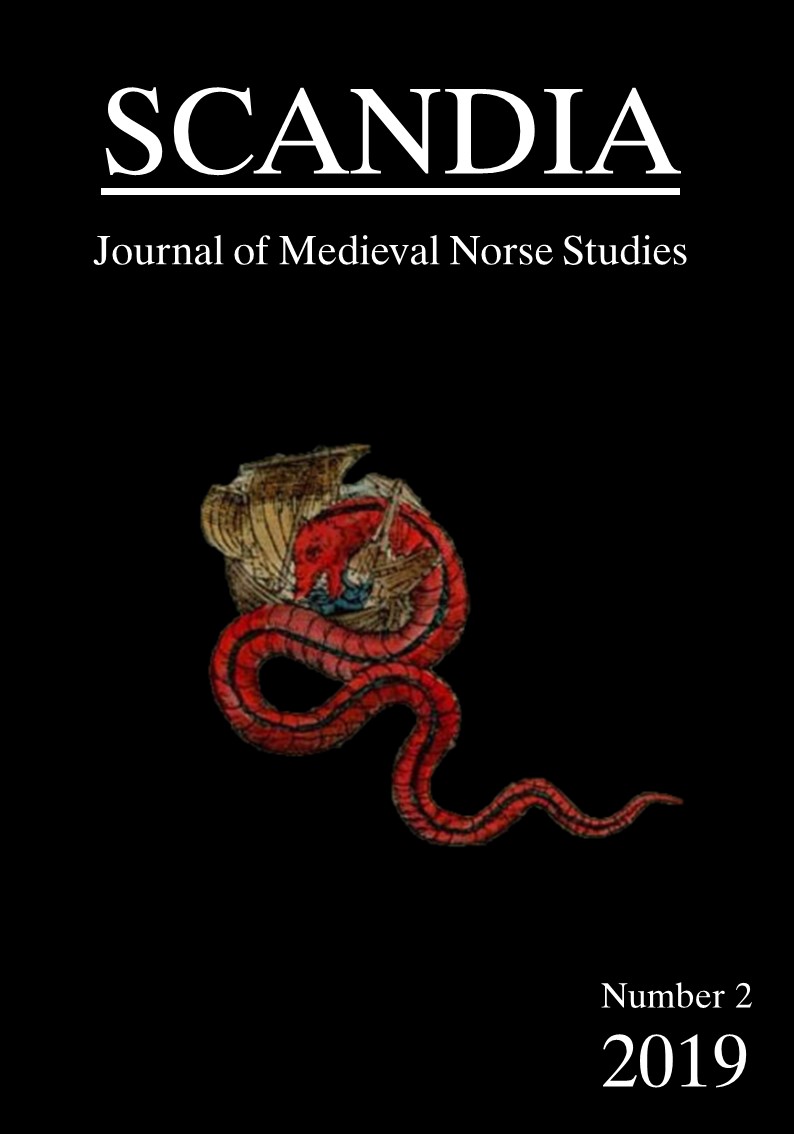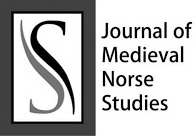Valfǫðr, vǫlur, and valkyrjur: Óðinn as a queer deity mediating the warrior halls of Viking Age Scandinavia
Resumo
Óðinn has long been a highly-debated figure in regard to his gender and sexuality. While some have interpreted him as a strictly masculine being, others have argued him to be queer, with caveats surrounding how this affected his role as a deity. I use a queer theoretical framework to firstly streamline my interpretation of Óðinn’s gender, and set this within both a cultural context and a queer context. I then turn my attention to the context of the warrior hall. I demonstrate that the interpretation that this was a strictly masculine space is based in scholarly bias, primarily argued by Otto Höfler as part of his work for the Nazi Party, and has not since been sufficiently critically challenged. After reassessing the primary material to demonstrate the gender dynamics of the warrior hall, I then demonstrate that, by blurring boundaries and queering his gender, Óðinn acts in a way that mediates between the roles of men and women within the culture of the hall
Downloads
Referências
Primary Sources:
FULK, R. D., “Eyvindr skáldaspilir Finnsson, Hákonarmál”. In WHALEY, Diana (Ed.). Poetry from the Kings’ Sagas I: From Mythical Times to c.1035. Turnhout: Brepols, 2012a, pp. 171-195.
FULK, R. D., “Anonymous, Eiríksmál”. In WHALEY, Diana (Ed.). Poetry from the Kings’ Sagas I: From Mythical Times to c.1035. Turnhout: Brepols, 2012b, pp. 1003-1013.
Jónas Kristjánsson & Vésteinn Ólason (Ed.). Eddukvæði I: Góðakvæði. Íslenzk Fornrit. Reykjavík: Hið Íslenzka Fornritafélag. 2014.
Jónas Kristjánsson & Vésteinn Ólason (Ed.). Eddukvæði II: Hetjukvæði. Íslenzk Fornrit. Reykjavík: Hið Íslenzka Fornritafélag. 2014.
Snorri Sturluson. Heimskringla I. Bjarni Aðalbjarnarson (Ed.). Reykjavík: Hið Íslenzk Fornritafélag, 1941.
Snorri Sturluson. Edda: Skáldskaparmál I: Introduction, Text and Notes. FAULKES, Anthony (Ed.). London: Viking Society for Northern Research, 1998.
Snorri Sturluson. Edda: Prologue and Gylfaginning. FAULKES. Anthony (Ed.). London: Viking Society for Northern Research, 2005.
Seconday Literature:
AIZURA, Aren Z.; COTTEN, Trystan; LAGATA, Carla/Carsten Balzer; OCHOA, Marcia; VIDAL-ORTIZ, Salvador. “Introduction.” TSQ: Transgender Studies Quarterly, 2014, 1, 3, pp. 308-319.
ARWILL-NORDBLADH, Elisabeth. “Negotiating Normatives – ‘Odin from Lejre’ as Challenger of Hegemonic Order.” Danish Journal of Archaeology, 2013, 2, 1, pp. 87-93.
ASSION, Peter. “Eugen Fehrle and ‘The Mythos of Our Folk’”. In: DOW, James R., & LIXFELD, Hannjost (Ed.). The Nazification of an Academic Discipline. Bloomington & Indianapolis: Indiana University Press, 1994, 112-134.
Ármann Jakobsson. “Óðinn as Mother: The Old Norse Patriarch”. Arkiv för nordisk filologi, 2011, 126, pp. 5-16.
BAEUMLER, Alfred. Männerbund und Wissenschaft. Berlin: Junter und Dünnhaupt Verlag, 1934.
BINAOHAN, b. decolonizing trans/gender 101. biyuti publishing, 2014.
BLACKMORE, Chelsea. “How to Queer the Past without Sex: Queer Theory, Feminisms and the Archaeology of Identity.” Archaeologies: Journal of the World Archaeological Congress, 2011, 7, 1, pp. 75-96.
BOCKHORN, Olaf. “The Battle of the “Ostmark”: Nazi Folkore in Austria”. In: DOW, James R., & LIXFELD, Hannjost (Ed.). The Nazification of an Academic Discipline. Bloomington & Indianapolis: Indiana University Press, 1994, 135-155.
BRINK, Stefan. “How Uniform was the Old Norse Religion?” In: QUINN, J; HESLOP, K; WILLS, T (Ed.). Learning and Understanding in the Old Norse World: Medieval Texts and Cultures of Northern Europe. Turnhout: Brepols, 2007, pp. 105-136.
CHRISTENSEN, Tom. ”Lejre: Fact and Fable”. In: NILES, John D. Beowulf and Lejre. Arizona: Arizona Centre for Medieval and Renaissance Studies, 2007, pp. 21-102.
CHRISTENSEN, Tom. “Odin fra Lejre.” In: MOSES, Søren (Ed.). ROMU 2009: Årsskrift fra Roskilde Museum. Rosklide: Roskilde Museums Forlag, pp. 2009, 7-25.
CLOVER, Carol J. “Regardless of Sex: Men, Women, and Power in Early Northern Europe”. Speculum, 1993, 68, 2, pp. 363-387.
CLUNIES ROSS, Margaret. “The Transmission and Preservation of Eddic Poetry”. In: LARRINGTON, Carolyne; QUINN, Judy; & SCHORN, Brittany (Eds.). A Handbook to Eddic Poetry: Myths and Legends of Early Scandinavia. Cambridge: Cambridge University Press, 2016, pp. 12-32.
DE VRIES, Jan. Altergermanische Religiongeschichte. Berlin: Walter De Gruyter & Co, 1970.
DOW, James R., & LIXFELD, Hannjost. “Introduction”. In: The Nazification of an Academic Discipline. Bloomington & Indianapolis: Indiana University Press, 1994, xi-xx.
DOWNS, Laura Lee. Writing Gender History. New York: Oxford University Press, 2010.
EMMERICH, Wolfgang. “The Mythos of Germanic Continuity”. In: DOW, James R., & LIXFELD, Hannjost (Ed.). The Nazification of an Academic Discipline. Bloomington & Indianapolis: Indiana University Press, 1994, 34-54.
ENRIGHT, Michael. Lady with a Mead Cup: Ritual, Prophecy and Lordship in the European Warband from La Téne to the Viking Age. Dublin: Four Courts Press, 1996.
EVANS, Ruth. ‘Gender does not equal genitals,’ postmedieval: a journal of medieval cultural studies, 9, 2018, 120-131.
GARDEŁA, Leszek. (Magic) Staffs in the Viking Age. Wien: Fassbaender, 2016.
GHISLENI, Lara; JORDAN, Alexis M.; & FIOCCOPRILE, Emily. ”Introduction to ”Binary Binds”: Deconstructing Sex and Gender Dichotomies in Archaeological Practice”. Journal of Archaeological Method and Theory, 2016, 23, 3, pp. 765-787.
GUNNELL, Terry. “Pantheon? What Pantheon? Concepts of a Family of Gods in Pre-Christian Scandinavian Religions”. Scripta Islandica, 2015, 66, pp. 55-76.
HALBERSTAM, Jack. Female Masculinity. Durham: Duke University Press Books, 1998.
HAUSMANN, Frank-Rutger. Auch im Krieg schweigen die Musen nicht: Die Deutschen Wissenschaftlischen Institute im Zweiten Welkrieg. Göttingen: Vanenhoeck und Ruprecht, 2002.
HEDEAGER, Lotte. Iron Age Myth and Materiality: An Archaeology of Scandinavia AD 400-1000. Abingdon: Routledge, 2011.
HEDENSTIERNA-JONSON, Charlotte; KJELLSTRÖM, Anna; ZACHRISSON, Torun; KRZEWIŃSKA, Maja; SOBRADO, Veronica; PRICE, Neil; GÜNTHER, Torsten; JAKOBSSON, Matthias; GÖTHERSTRÖM, Anders; STORÅ, Jan. “A Female Viking Warrior Confirmed by Genomics”. American Journal of Physical Anthropology, 2017, 164, 4, pp. 853-860.
HEIDE, Elder. “Spinning Seiðr”. In: ANDRÉN, Anders; JENNBERT, Kristina; RAUDVERE, Catharina (Eds.). Old Norse Religion in Long Term Perspectives: Origins, Changes, and Interactions. Lund: Nordic Academic Press, 2006, pp. 164-170.
HÖFLER, Otto. Kultische Geheimbünde der Germanen. Frankfurt am Main: Verlag Moritz Diesterweg, 1934.
IPSEN, Gunther. “Weiser Lily. Altergermaische Jünglingsweihen und Männerbunde. Ein Beitrag zur deutschen und nordischen Altertums- und Volkskunde. (Heft 1 der Bausteine zur Volkskunde und Religionswissechschaft, hesusg. Von. Eu. Fehrle.) Konkordia A.-G. Bühl (Baden) 1927. 94S. 8°. 3 RM.” Zeitschift für Indogermanistik und historische Sprachwissenschaft, 1928, 46, 1, p. 274.
JEFFORD FRANKS, Amy. “Óðinn: A Queer týr? A Study of Óðinn’s Function as a Queer Deity in Iron Age Scandinavia”. MA Thesis, University of Iceland, 2018.
JENSEN, Jeppe Sinding. ”Conceptual Models in the Study of Religion.” In: CLARKE. Peter B. (Ed.). The Oxford Handbook of the Sociology of Religion. Oxford: Oxford University Press, 2009, 245-262.
Jóhanna Katrín Friðriksdóttir. “Foreword.” Kyngervi, 2019, 1, pp. 9-14.
KERSHAW, Kris. The One-eyed God: Odin and the (Indo-)Germanic Männerbunde. Washington: Journal of Indo-European Studies, 2000.
KVIDELAND, Reimund. “Lily Wieser Aal”. Norsk biografisk leksikon. Accessed 21 May 2019. nbl.snl.no/Lily_Weiser_Aall.
LINDOW, John. Comitatus, Individual and Honor: Studies in North Germanic Institutional Vocabulary. Berkeley: University of California Press, 1975.
LINDOW, John. Norse Mythology: A Guide to the Gods, Heroes, Rituals, and Beliefs. Oxford: Oxford University Press, 2001.
LUND, Allan A. & MATEEVA, Anna S. “Gibt es in der Taciteischen ‘Germania’ Beweise für kultische Männerbunde der frühen Germanen?”. Zeitschrift für Religions- und Geistesgeschichte, 1999, 49, 3, pp. 208-216.
MANEA, Irina Maria. “Instrumentalising the Past: The Germanic Myth in National Socialist Context”. Romanian Journal of History and International Studies, 2014, 1, pp. 71-85.
MANNERING, Ulla. “Man or Woman? – Perception of Gender Through Costume”. Danish Journal of Archaeology, 2013, 2, 1, pp. 79-86.
MEIER, Mischa. “Zum Problem der Existenz kultischer Geheimbünde bei frühen Germanen: Tacitus, Germania Kap. 31, 83 und 43”. Zeitschrift für Religions- und Geistesgeschichte, 1999, 51, 4, pp. 322-341.
MEULENGRACHT SØRENSEN, Preben. The Unmanly Man: Concepts of Sexual Defamation in Early Northern Europe. Odense: Odense University Press, 1983.
MORAL, Enrique. “Qu(e)erying Sex and Gender in Archaeology: A Critique of the “Third” and Other Sexual Categories”. Journal of Archaeological Method and Theory, 2016, 23, 3, pp. 788-809.
MURPHY, Luke John. “Herjans dísir: Valkyrjur, Supernatural Femininities, and Elite Warrior Cultre in the Late-Pre Christian Iron Age”. MA Thesis, University of Iceland, 2013.
MURPHY, Luke John. ”Between Unity and Diversity: Articulating Pre-Christian Nordic Religion and its Spaces in the Late Iron Age”. PhD Dissertation, Aarhus University, 2017.
NORDBERG, Andreas. “Krigarna i Odins sal: Dödsföreställningar och krigarkult i fornnordisk religion”. PhD Dissertation, University of Stockholm, 2004.
PRICE, Neil. The Viking Way: Religion and War in Late Iron Age Scandinavia. Uppsala: Department of Archaeology and Ancient History, 2002.
PRICE, Neil & MORTIMER, Paul, ‘An Eye for Odin? Divine Role-Playing in the Age of Sutton Hoo,’ European Journal of Archaeology, 17, 3, 2014, 517-538.
RYLE, Robin. Questioning Gender: A Sociological Exploration. Los Angeles: SAGE Publications Inc., 2012.
SCHJØDT, Jens Peter. Initiations Between Two Worlds: Structure and Symbolism in Pre-Christian Scandinavian Religion. Odense: The University Press of Southern Denmark, 2008.
SCHJØDT, Jens Peter. ”Reflections on Aims and Methods in the Study of Old Norse Religion”. In: RAUDVERE, Catherine & SCHJØDT, Jens Peter (Eds.). More than Mythology: Narratives, Ritual Practices and Regional Distribution in Pre-Christian Scandinavian Religions. Lund: Nordic Academic Press, 2012, pp. 263-287.
SCHJØDT, Jens Peter. “The Notions of Model, Discourse, and Semantic Center as Tools for the (Re)Construction of Old Norse Religion”. The Retrospective Methods Network Newsletter, 2013, 6, pp. 6-15.
SCHJØDT, Jens Peter. “Eddic Poetry and the Religion of Pre-Christian Scandinavia”. In: LARRINGTON, Carolyne; QUINN, Judy; & SCHORN, Brittany (Eds.). A Handbook to Eddic Poetry: Myths and Legends of Early Scandinavia. Cambridge: Cambridge University Press, 2016, pp. 132-146.
SCHURTZ, Heinrich. Alterklassen und Männerbünde. Eine Darstellung der Grundformen der Gesellschaft. Berlin: Druck und Verlag von Georg Reimer, 1902.
SIMEK, Rudolf. Dictionary of Northern Mythology. Cambridge: Boydell and Brewer, 1993.
SOLLI, Brit. “Queer theory og gamle guder. Skeive perspective på norrøn mytologi”. In: LOTHERINGTON, Ann Therese & MARKUSSEN, Turid (Ed.). Kritisk kunnskapspraksis: Bidrag til feministisk vitenskasteori, Oslo: Spartacus Forlag As, 1998, pp. 241-264.
SOLLI, Brit. “Queering the Cosmology of the Vikings: A Queer Analysis of the Cult of Odin and ‘Holy White Stones’”. Journal of Homosexuality, 2008, 54, 1-2, pp. 192-208.
STRÖMBÄCK, Dag. Sejd: Textstudier i nordisk religionshistoria. Stockholm: Geber, 1935.
SVANBERG, Fredrik. Decolonizing the Viking Age 1. Stockholm: Almqvist & Wiksell International, 2003.
TOLLEY, Clive. Shamanism in Norse Myth and Magic: Volume 1. Helsinki: Suomalainen Tiedeakatemia, 2009.
VON SEE, Klaus; LA FARGE, Beatrice; PICARD, Eve; PRIEBE, Ilone; & SCHULZ, Katja. Kommentar zu Liedern der Edda. Bd. 2: Götterlieder (Skírnismál, Hárbarðsljóð, Hymiskviða, Lokasenna, Þrymskviða). Heidelberg: Winter, 1997.
WEISER, Lily. Altgermanische Jünglingsweihen und Männerbünde – Ein Beitrag zur deutschen und nordischen Altertums- unf Volkskunde. Baden: Druck und Verlag der Konkordia A.-G., 1927.
Downloads
Publicado
Edição
Seção
Licença
O(s) autor(es) do original apresentado se compromete(m) a cumprir o que se segue:
- Todos os autores responsabilizam-se publicamente por ele.
- Os autores afirmam que este original é de sua autoria e que assumem integral responsabilidade diante de terceiros, quer de natureza moral ou patrimonial, em razão de seu conteúdo, declarando desde já que a obra não infringe quaisquer direitos de propriedade intelectual de terceiros.
- O(s) autor(es) concordam em ceder os direitos autorais do original à Revista Scandia, à qual concedem permissão para sua reprodução, edição e publicação on-line.
- O(s) autor(es) outorgam seus direitos autorais de seu original à Revista Scandia, licendiado sob a Criative Commons Attribution License, que permite o compartilhamento deste trabalho com o reconhecimento de sua autoria.
- O(s) autor(es) têm permissão e são estimulados a citar e distribuir seu original.



